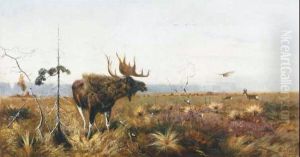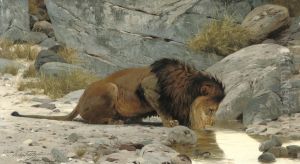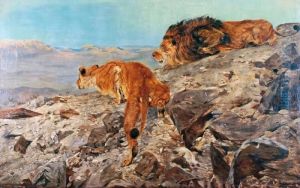Richard Bernhard L. Friese Paintings
Richard Bernhard Ludwig Friese was a German artist known primarily for his wildlife paintings. Born on June 5, 1854, in Głogów (then known as Glogau), in the Prussian Province of Silesia, Friese demonstrated a talent for art at a young age. His interest in animals and natural history was also evident early in his life, which would later significantly influence his artistic career.
After initial education in his hometown, he pursued his passion for art by studying at the Royal Academy of Arts in Berlin. His talent was recognized by the renowned animal painter Paul Meyerheim, who took him under his wing. Meyerheim was instrumental in shaping Friese's approach to art, particularly in terms of depicting animals in their natural environments.
Friese's work is characterized by its detailed realism and the lifelike portrayal of animals. He was particularly adept at capturing the textures of fur and the expressive qualities of his animal subjects. His paintings often depicted scenes from the wild, capturing the essence of the European forests, the African savannas, and the Arctic tundra. Friese's travels to these regions provided him with the firsthand experience and inspiration that he needed to create his works.
Throughout his career, Friese became a well-respected figure in the field of animal painting. His works were exhibited in various galleries and won him awards, securing his reputation as one of the leading animal painters of his time. He was a member of the Berlin Secession, a group that sought to break away from the traditional academic style of art that dominated Germany at the time.
Despite his success, Richard Friese remained committed to his artistic vision, which was grounded in a deep respect for nature and its creatures. His paintings continue to be celebrated for their beauty and precision, and they have been collected by numerous art museums and private collectors around the world.
Richard Bernhard Ludwig Friese passed away on January 10, 1918, leaving behind a legacy as one of the most important wildlife artists of the late 19th and early 20th centuries. His work remains an important part of the canon of wildlife art and continues to inspire both artists and animal lovers alike.


